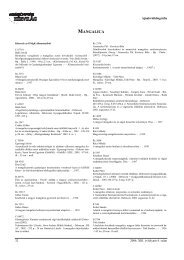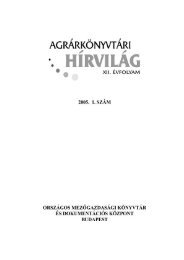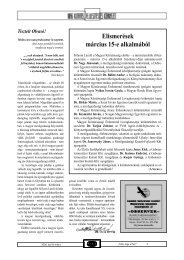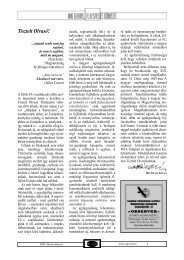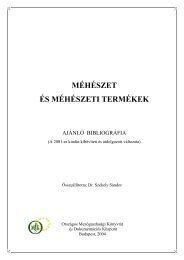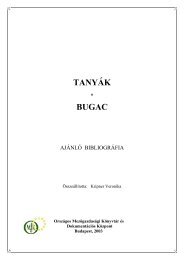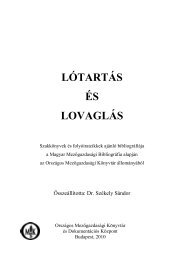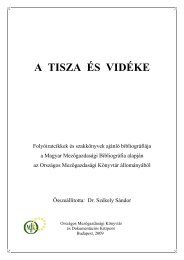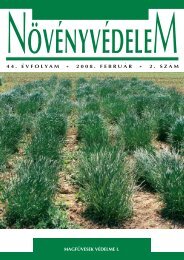hUNGARiAN AGRicUltURAl RESEARch
hUNGARiAN AGRicUltURAl RESEARch
hUNGARiAN AGRicUltURAl RESEARch
You also want an ePaper? Increase the reach of your titles
YUMPU automatically turns print PDFs into web optimized ePapers that Google loves.
around the peduncle. This<br />
group contains also the<br />
genotypes which raise the<br />
flower buds on spurs so the<br />
amount of the destroyed shoots<br />
is imperceptible (functional<br />
resistance).<br />
2 Semi sensitive: the amount of<br />
the destroyed flowers is less<br />
than 20% of the total fruit set.<br />
Most of the hybrids and<br />
cultivars of the experimental<br />
orchard belong to this group.<br />
3 Sensitive: more than 20% of<br />
the flowers are destroyed every<br />
year. This level of symptoms<br />
appears even if the blossoming<br />
period is dry.<br />
Table 1. Groups of Monilia resistance / susceptibility among different<br />
apricot genotypes<br />
(0) (1) (2) (3)<br />
Totally resistance Tolerant Semi sensitive Sensitive<br />
Hybrid 1/33<br />
(P. cerasifera x Zard Nikitszkij Ceglédi óriás<br />
P. armeniaca)<br />
P. salicina<br />
Methley<br />
Results of the evaluation are<br />
shown in Table 1 and Figure 1.<br />
The next step of the study was<br />
to determine the genetic background<br />
of resistance and clarifying<br />
the particular mechanisms of<br />
infection. According to the widely<br />
accepted explanation, the infection<br />
process begins when conidia<br />
enters the pistils through the<br />
stigmata. The base of this theory is<br />
rooted in the infection mechanism<br />
of Monilia laxa in sour cherry<br />
where stigmata is completely<br />
destroyed following the penetration<br />
of the pathogen. Accordingly,<br />
we supposed that the key<br />
of the resistance could be in the<br />
pistils or in the secretum.<br />
Observing flowers used in the<br />
crosses carried out as the part of<br />
the apricot breeding work going on<br />
at the department, it was clearly<br />
visible that emasculated and handpollinated<br />
flowers did not show<br />
any symptoms of the Monilia<br />
Pannónia Konzervnij pozdnij Mari de Csanad<br />
P. salicina<br />
considering Magyarkajszi C.235 Harmat Mandulakajszi<br />
Burbank<br />
P. dasycarpa Venusz Konkurencia Goldrich<br />
P. cerasifera 23/22 Gönci magyarkajszi Ceglédi arany Ceglédi bíborkajszi<br />
Harcot<br />
Orange red<br />
Korai zamatos<br />
Ceglédi Piroska<br />
infection. The same opinion was<br />
reported by Bulgarian breeders<br />
(Tzonev and Yamaguchi, 1999).<br />
According to their experiences the<br />
pathogen cannot penetrate the<br />
forced pollinated pistil of<br />
emasculated flowers. Their hypothesis,<br />
explaining this observation,<br />
was that the pollinated pistils<br />
produce protective substances,<br />
which do not allow the infection<br />
3.0<br />
2.5<br />
2.0<br />
1.5<br />
1.0<br />
0.5<br />
0.0<br />
Hybrid 1/33 P.cer.x P. a.<br />
P. salicina 'Methley'<br />
P.salicina 'Burbank'<br />
P. dasycarpa<br />
P.cerasifera (alany)<br />
Zard<br />
Magyar kajszi C.235<br />
Pannónia<br />
Gönci magyarkajszi<br />
Venusz<br />
Nikitszkij<br />
Harmat<br />
Konzervnij pozdnij<br />
Konkurencia<br />
Priuszadebnij rannij<br />
Ceglédi arany<br />
Ceglédi óriás<br />
Mari de Csanad<br />
Effekt<br />
Mandulakajszi<br />
Sungiant<br />
Ceglédi bíborkajszi<br />
Harcot<br />
Baneasa 4/11<br />
Orange red<br />
Korai zamatos<br />
Ceglédi Piroska<br />
Mamaia<br />
Goldrich<br />
Marculesti 18/6<br />
Aurora<br />
Sulmona<br />
Kecs-psar<br />
Figure 1. Ranking of apricot cultivars considering their susceptibility to Monilia laxa<br />
(Szigetcsép, 2004–2009).<br />
The totally resistant cultivars got 0 and the most susceptible cultivars got 3.<br />
18 Hungarian Agricultural Research 2009/3–4



